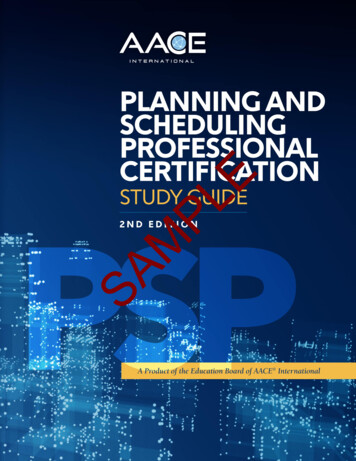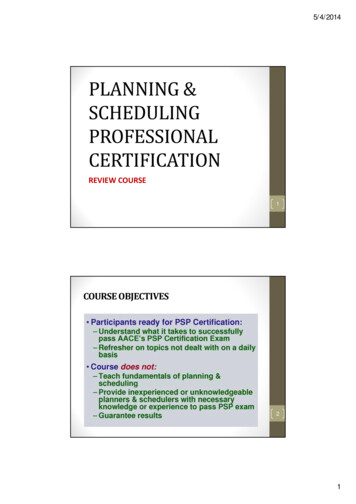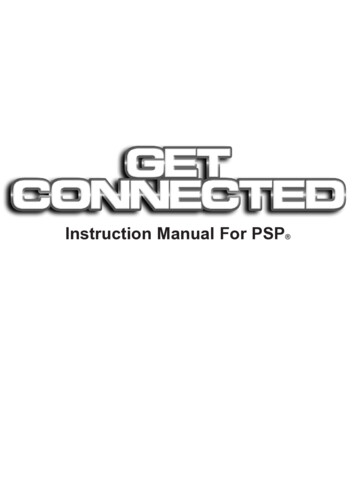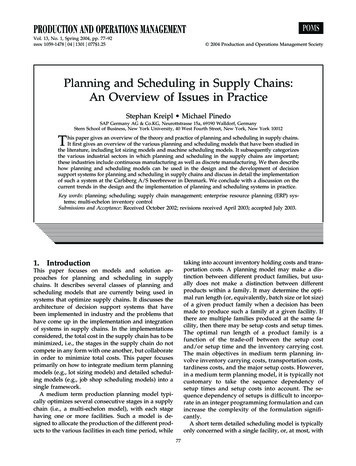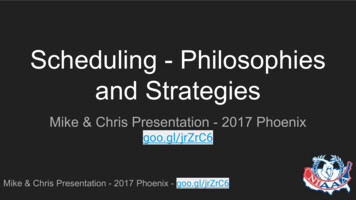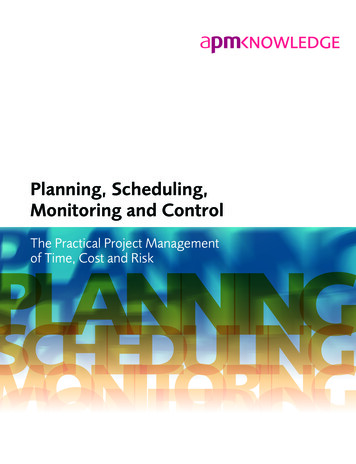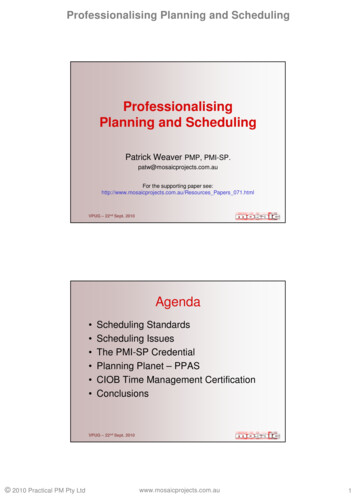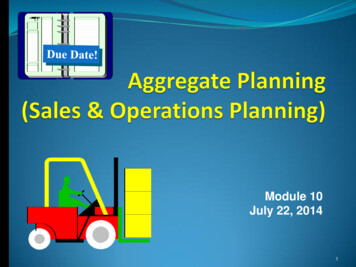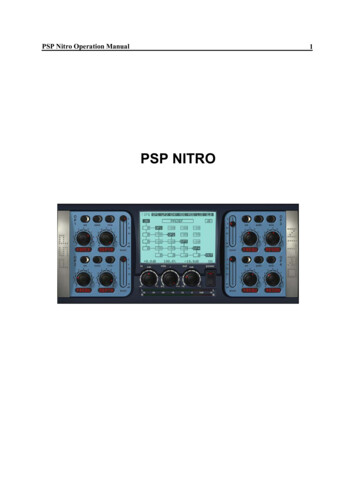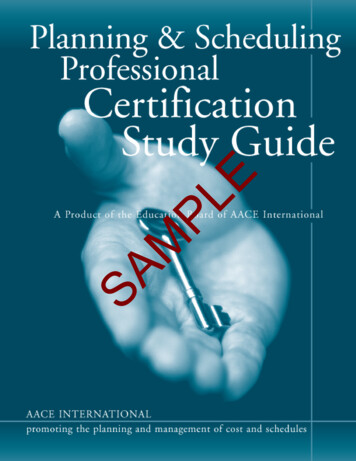
Transcription
EPLMSA
SAMPLEPlanning and Scheduling Professional(PSP)Certification Study Guide2014
MPLEPlanning and Scheduling Professional (PSP)Certification Study GuideFirst Edition, RevisedCopyright 2008By AACE International1265 Suncrest Towne CentreMorgantown, WV 26505-1876 USAPhone : 1.304.2968444Fax: 1.304.2915728Email : info@aacei.orgWeb : www.aacei.orgSAPrinted in the United States of AmericaPrinted by CreateSpaceISBN: 978-1469968919
A Special PublicationofAACE International – The Authority for Total Cost ManagementPLEPlanning and Scheduling Professional(PSP)Certification Study GuideSAMFirst Edition, Revised2014A continuing project of the AACE International Education Board
SAMPLEPlease see Acknowledgments on the next page
AcknowledgmentsThis study guide reflects the work of those individuals who were on the original task force thatdeveloped AACE International’s Planning and Scheduling Professional (PSP) Certification Exam, whichincluded an initial PSP knowledge outline. Contributions from others interested in this effort were alsoessential.The 2007-2008 AACE International Education Board is grateful to the AACE International members whohave assisted in the development of this PSP Certification Study Guide, including:EPeter W. Griesmyer, EditorDr. John O. Evans, III Ph.D. PSPDonald F. McDonald, Jr., PE CCP PSPBarrett L. Richards CCP PSPSAMPL2007/2008 Education Board Members:Harry Jarnagan, PE CCP (Chair)Mahendra (Pal) BhatiaChris A. Boyd, CCPMark T. Chen, PE CCPAudrey M. Clark, CCPJohn O. Evans, III PSPClive Francis, CCPProf. John (Jeff) HannonDr. Mark Hastak, Ph.D. CCPDonald F. McDonald, Jr., PE CCP PSPSean Regan, CCPBarrett Richards, CCP PSPPeter W. Griesmyer
AACE International’s Education Board is grateful to AACE International members and others who haveassisted in the development and review of this PSP Certification Study Guide:ETimothy T. Calvey PE PSPEdward E. (Ted) Douglas, III CCP PSPMorris E. Fleishman PE CCEMarc S. Glasser PSPLee J. HobbFredric L. (Fred) Plotnick PELawrence R. (Lars) Tanner PSPRonald W. (Ron) Winter PSPPLThe assistance and support of the AACE International Headquarters (HQ) staff members are also greatlyappreciated:SAMDennis G. Stork, Executive DirectorMarvin Gelhausen, Managing EditorNoah Kinderknecht, Art DirectorRobin Donley, IT/IM/Graphics SpecialistCharla Miller, Staff Director-Education and AdministrationPenny Whoolery, Manager, Certification
ContentsIntroduction to the PSP Certification Study Guide . 1PSP Certification Policies, Procedures and Examination Structure . 4PSP Certification Requirements and Process . 5Test Your PSP Knowledge . 9SAMPLECHAPTER 1 – PLANNING . 111A. Planning Development . 151.1 Input and Data. 171.1.1 Contract Requirements . 191.1.2 Identification of Stakeholders . 231.1.3 Constructability Methods . 271.2 Considerations and Constraints . 311.2.1 Identification of Resources . 331.2.2 Value Engineering . 371.2.3 Stakeholder Considerations. 411.2.4 Project Variables . 451B. Planning Product. 491.3 Planning Output and Deliverables . 511.3.1 Define Scope of Work . 531.3.2 Define Project Goals . 571.3.3 Define Project Plan . 611.3.4 Phase Definition. 651.3.5 Establish Work Breakdown Structure (WBS) . 691.3.6 Establish Organizational Breakdown Structure (OBS) . 751.3.7 Cost Breakdown Structure (CBS) . 791.3.8 Sequencing and Phase Relationships . 831.3.9 Review by Stakeholders . 871.3.10 Cost Estimate Development . 911.3.11 Baseline Plan. 951.3.12 Periodic Forecasts . 1011.3.13 Risk and Recovery Plan . 105CHAPTER 2 – SCHEDULING . 1092A. Schedule Development . 1112.1 Input and Data (from Planning). 1132.1.1 Define Schedule Scope . 1152.1.2 Breakdown Structures (WBS/OBS/CBS) . 1192.1.3 Schedule Specification . 1232.1.4 Feedback from Stakeholders . 1292.1.5 Cost Estimate Model . 1332.2 Creating Schedule . 1372.2.1 Types of Schedules . 1392.2.2 Activities . 1432.2.3 Durations . 1472.2.4 Relationships . 1512.2.5 Constraints and Calendars . 1572.2.6 Cost/Resource Loading . 1632.2.7 Milestones . 1692.2.8 Schedule Quality Analysis and Compliance Review . 1732.2.9 Schedule Basis Documentation . 177
SAMPLAppendicesAppendix A—Complex ProblemsAppendix B—Recommended References and ResourcesAppendix C—PSP Glossary of TermsAppendix D—AACE International Canons of EthicsAppendix E—List of Versions/Revisions/ChangesE2B. Schedule Maintenance/Controlling . 1812.3 Maintain Schedule. 1832.3.1 Baseline Schedule . 1852.3.2 Tracking Schedule Progress . 1892.3.3 Cost and Resource Management . 1952.3.4 Schedule Change Management . 1992.3.5 Acceleration . 2032.3.6 Schedule Maintenance Feedback . 2092.4 Schedule Output and Deliverables . 2132.4.1 Control Level Schedules. 2152.4.2 Variances and Trends . 2192.4.3 Schedule Analysis . 2232.4.4 Schedule Forecasts . 2312.4.5 Constructability Review . 2352.4.6 Progress Reports and Reviews . 2392.4.7 Recovery Schedules . 2432.4.8 Management Summary . 247
PREFACEAACE International’s Planning and Scheduling Professional (PSP) Certification Study Guide wasdeveloped to accomplish two purposes similar to that of the CCP Certification Study Guide. First, it aidsprofessionals wishing to achieve AACE International’s specialty certification in Planning and Scheduling.Second, the PSP Certification Study Guide summarizes various topics considered central to the planningand scheduling profession, as outlined in AACE International Recommended Practice 14R-90,Responsibility and Required Skills for a Planning and Scheduling Professional, along with the currentedition of the Skills and Knowledge of Cost Engineering.PLEThe PSP Certification Study Guide should be a beneficial and useful publication for all planning andscheduling professionals. It primarily serves the needs of planning and scheduling professionals who arepreparing to take AACE International’s PSP certification examination. This publication is intentionallyconcise and does not delve deeply into any subject, yet it broadly touches upon all topics within therequired skills and knowledge of a planning and scheduling professional. This text is not intended to bea source of detailed planning and scheduling knowledge, nor does it substitute for the minimumexperience necessary to qualify to sit for and pass the PSP certification exam. That is, the reader will notfind deep development of planning and scheduling concepts in this manual, since listed references arealready available to provide all necessary details. Rather, it introduces required knowledge and skills forpotential PSP certificants.MMuch of the information contained in this PSP Certification Study Guide parallels and amplifiesinformation presented in Skills and Knowledge of Cost Engineering and the CCP Certification StudyGuide. These publications can be used together for study of fundamental cost engineering, as well asessential planning and scheduling. They also include sample problems related to the subject matter.SAThe PSP Certification Study Guide incorporates terms and phrases that are generic to the profession,and some are specific to AACE International. Terms and phrases used in industry and technical softwaremay not always agree precisely with one’s previous understanding, or how the terms are used in aspecific organization or industry. One should consult the list of terms found in Appendix C and theterminology definitions in the latest edition of AACE International Recommended Practice 10S-90, CostEngineering Terminology, to learn the definitions as applied in the exam. AACE International’sRecommended Practices can be obtained from AACE International’s web site at www.aacei.org.The AACE Education Board will continue to improve this publication, revising and improving it as neededto support the PSP exam, enhancing its value as described above. Recommended changes and updatesare highly welcome and should please be forwarded to the AACE International Education Board atedchair@aacei.org.
SAMPLEPlease see Introduction to PSP Certification Study Guide on the next page
AACE InternationalPlanning and Scheduling Certification Study GuideIntroduction to PSP Certification Study GuideAACE International’s PSP Certification Study Guide enables users to understand the scope of the PSPCertification Examination and prepare for it. It does not provide fundamental education in the basicsof planning and scheduling. Whoever uses this guide should already possess the minimum PSPeducation and work experience as required to sit for the PSP certification exam. The guide informsPSP applicants of subjects that the exam tests, poses representative questions and problems, andlists useful references for detailed study.EThis text uses a typical engineering-procurement-construction (EPC) project as the basis forpresenting knowledge and concepts integral to planning and scheduling. Further, it uses the term“project” in its generic form while recognizing the knowledge and skills can apply to multiple projectsor a “program.” However, these concepts, tools, and techniques are applicable to the majority ofindustries that rely on planning and scheduling professionals to effectively manage work. Thisincludes aerospace, agriculture, telecommunications, ship building, software development, resourceplanning and management, manufacturing, and others.PLIn addition to the EPC model for construction, process and industrial operations have beenincorporated into the development of the PSP Certification Study Guide. Other major themesinclude:The planning process extends from conceptual through delivery phases.oPlanning includes design and engineering development.oThe change management process is considered throughout all phases.oStakeholders’ interests are presented with emphasis on considerations and constraints.oHuman issues are presented with emphasis on health, welfare, safety, and environment.MoSAThe study guide is organized according to Scope of Knowledge (see figure 1), and the taxonomy liststhe knowledge areas that may be tested.The PSP Certification Study Guide begins by discussing the PSP Certification Examination Structure.The guide discusses the topics outlined in Figure 1 by identifying the following:ooIntroduction and Learning ObjectivesRelated SectionsoTerms to KnowoKey Points for ReviewoSummaryoSample Questions 2014, AACE International (All Rights Reserved)Page 1
AACE InternationalPlanning and Scheduling Certification Study GuideThe PSP Certification Study Guide is divided into two main chapters (Planning and Scheduling) andtwo sections in both of those chapters:oPlanning. Planning development. Planning product.oScheduling. Schedule development. Schedule maintenance and reporting.oComplex problem.oAppendix. Recommended references and resources. PSP certification glossary.Answers to questions and complex problem.SAMPLoE Sample application. 2014, AACE International (All Rights Reserved)Page 2
Planning and Scheduling Certification Study GuideSAMPLEAACE InternationalFigure 1—Scope of Knowledge, Planning and Scheduling Professional (PSP) 2014, AACE International (All Rights Reserved)Page 3
AACE InternationalPlanning and Scheduling Certification Study GuideCertification Policies, Procedures and Examination StructureThe most current information regarding AACE certification is posted on our website atwww.aacei.org, under the Certification tab.A summary of the steps to become AACE certified is that the candidate must do the following, inorder:E1. Meet the minimum eligibility requirements (it is the responsibility of the candidate to ensurethey can meet the eligibility requirements prior to registering for the examination).2. Register and pay for the (certification) exam.3. Submit all verification documentation and other required documents tocertificationsubmittals@aacei.org within 30-days of registering.4. Schedule an exam at a Kryterion testing center after receiving clearance from Headquarterswithin 6 months of clearance.5. Successfully pass a written examination as determined by the AACE InternationalCertification Board.PLAll AACE certification examinations are conducted through computer based testing at Kryteriontesting centers worldwide.Our website contains all the necessary information for becoming certified, including exam andscheduling tutorials, exam specific toolbox – containing helpful documents and guides, and therecommended resources to assist in preparing for the certification examination. Please visit ourwebsite at www.aacei.org for all of your certification questions and needs.SAMAll certification related questions should be directed to certification@aacei.org or 1-800-858-2678. 2014, AACE International (All Rights Reserved)Page 4
AACE InternationalPlanning and Scheduling Certification Study GuidePSP Certification Requirements and ProcessEligibilityFor the most current information regarding PSP eligibility requirements, visit the AACE website atwww.aacei.org under the Certification tab. It is also important to be aware of the certificationpolicies and procedures regarding certification registration, payment, and examination scheduling,which can also be found on the AACE website.Examination FormatThe exam is delivered through computer based testing (CBT) and consists of multiple choicequestions and an essay-style question. The examination is closed book. Programmable or perprogrammed calculators (including those with financial functions) are also permitted.For the latest information regarding the PSP exam or recommended resources, visit the AACEwebsite at www.aacei.org, under the Certification tab.PLEPreparing for the PSP Certification ExaminationGenerally speaking a candidate’s education and professional experience are the primary sources thatprepare the individual for the examination. However, there are other ways to prepare for theexamination:oStudy the PSP Study Guide.oStudy the reference materials referenced in Appendix B of this manual.oLearn the planning and scheduling terms found in Appendix C of this manual, in conjunctionMwith AACE International Recommended Practice 10S-90, Cost Engineering Terminology.Access relevant distance learning opportunities through AACE International’s website.oAttend the PSP review seminar conducted at the AACE International Annual MeetingoAttend review sessions or seminars at AACE International Sections and Regions.oSAoAttend AACE International Section monthly meetings at least whenever the discussionincludes planning and scheduling topics. 2014, AACE International (All Rights Reserved)Page 5
AACE InternationalPlanning and Scheduling Certification Study GuidePSP Certification Examination StructureIntroductionTo be certified as a Planning & Scheduling Professional (PSP), a candidate must meet the minimumeligibility requirements and successfully pass a written examination as determined by the AACEInternational Certification Board. This study guide provides the information needed to prepare forthe PSP examination. All current information regarding PSP certification can be found on the AACEwebsite at www.aacei.org, under the certification tab.oEBasis of the ExaminationThe purpose of any professional certification or licensing program is to provide a mechanism toformally evaluate the individual’s knowledge and skill in a subject against widely accepted standards.Public recognition of the professional’s capabilities in the defined skill area may result. Certificationas a Planning and Scheduling Professional (PSP) recognizes certificate holders who havedemonstrated their experience and expertise in planning and scheduling. Planning and schedulingare respectively defined as:Planning – The identification of the project objectives and the orderly activities necessary toPLcomplete the project (the thinking part) and not to be confused with scheduling; the processby which the duration of the project task is applied to the plan. It involves answering thequestions:1. What must be done in the future to reach the project objective?M2. How it will be done?3. Who will do it?oSA4. When it will be done?Scheduling – (1) A description of when each activity in a project can be accomplished andmust be finished so as to be completed timely. The simplest of schedules depict in bar chartformat the start and finish of activities of a given duration. More complex schedules,generally in CPM format, include schedule logic and show the critical path and floatsassociated with each activity. (2) A time sequence of activities and events that represent anoperating timetable. The schedule specifies the relative beginning and ending times ofactivities and the occurrence times of events. A schedule may be presented on a calendarframework or on an elapsed time scale.These definitions of planning and scheduling provide the underlying basis for the AACE Internationalcertification examination. The examination tests professional proficiency across these areas. Thecandidate is directed to study from the Primary References in Appendix B.Planning and scheduling is a dynamic profession affected by advances in philosophies,methodologies, and technology. Professional planners and schedulers are expected to keep abreastof advances in these three realms. 2014, AACE International (All Rights Reserved)Page 6
AACE InternationalPlanning and Scheduling Certification Study GuideIn summary, the definition of a planner and scheduler and the Skills and Knowledge of CostEngineering (Planning and Scheduling chapters) determine the scope of the PSP certificationexamination. In recognition of this, the examination addresses:oMinimum knowledge covered by the basic skills documents; andoAdvanced knowledge based upon planning and scheduling experience.Examination StructureThe PSP exam is delivered through computer based testing (CBT) and consists of multiple choicequestions and a written exercise.PLE1. MULTIPLE CHOICE QUESTIONS: The exam is delivered through computer based testing(CBT)* and is comprised of multiple-choice and compound, scenario questions. The topicscovered in the exam are: basic planning& scheduling skills and knowledge, communicationcompetency, practical exercises, and planning & scheduling applications.2. MEMO ASSIGNMENT: The memo assignment provides a scenario and will require thecandidate to demonstrate both communication skills and insight regarding a challenging PSPworkplace scenario. The memo will be written in the text box provided onscreen and shoulddemonstrate a candidate’s ability to organize thought and communicate effectively. Thememo will need to be addressed properly, include a purpose statement, describe thepotential impact of any described problem or issue, propose a clear actionable solution withsupporting rationale and include a closing statement.MThe exam is closed book. Candidates are permitted to bring any style of calculator, includingprogrammable calculators, to use during the exam. Candidates will have a maximum of 5 hours tocomplete the exam.SAThe examination is not based upon use or knowledge of specific software, but rather embodies theknowledge and experience of a PSP practitioner using such tools. All materials provided during theexamination, including work paper, must be turned in upon completion of the examination.Recognizing that there are many industries and fields within the profession―engineering,construction, manufacturing, process facilities, mining, utilities, transportation, aerospace,environment and government―candidates can expect questions from any of these practices. Theexam takes into account the fact that no one can be expected to be conversant in all practice areasthrough its multiple-option format and extensive use of questions of general applicability.Understanding and Using the Sample Questions Provided in the PSP Study GuideThe PSP Study Guide includes many sample questions with answers. These questions should beanswered to you know which areas might need additional preparation on your part. The questionsare found at the end of each subchapter.PSP Study Guide questions have been developed specifically for those preparing for the examinationand are similar in content and context to the actual exam questions. All of the questions on the PSPCertification Examination, except the writing requirement, are multiple-choice questions. Each hasfour possible answers with one correct solution, whereas the questions in this Study Guide includeother forms of questions. 2014, AACE International (All Rights Reserved)Page 7
AACE InternationalPlanning and Scheduling Certification Study GuideQuestions in the PSP Study Guide are in the following formats:oMultiple choice questions, similar to what you might find on the certification examination.oFill-in-the-blank questions. These questions are intended to provide relevant thinkingexercises to support preparation for the examination.oA complex problem. The intent of this question-set is to enable the student to prepare forcomplex question section of the examination. The complex question sample is found inSAMPLEAppendix A. 2014, AACE International (All Rights Reserved)Page 8
AACE InternationalPlanning and Scheduling Certification Study GuideTest Your PSP KnowledgeAs a good gauge of PSP knowledge gained by using this study guide, the candidate is encouraged tostart by answering the following pre-test questions. Answers should be recorded, and when studiesare complete, the candidate will answer the same questions again. A close comparison of theresults, before and after study, will show the knowledge gained and what gaps may remain prior tositting for the exam.1. What is planning?2. Why is planning important?3. What is scheduling?4. Why is scheduling important?5. What is a work breakdown structure (WBS) and how is it used?6. What is a CPM schedule?E7. What are a planning and scheduling professional’s general duties and responsibilities?8. What are the different types of schedule activities and how are they used?PL9. Who are the stakeholders who use and work with plans and schedules?10. What does a forward and backward pass schedule calculation provide?11. What types of schedule logic and constraints are normally used and why are they important?12. What is the difference between ADM and PDM schedules and how do they differ?M13. What are schedule levels and why used?14. What makes for a successful plan?15. What makes for a successful schedule?SA16. Why do plans and schedules fail?17. Define basic steps in CPM schedule model development.18. What does modeling of resource utilization in the schedule provide?19. Define schedule calendars and their use.20. How are schedules updated for progress?21. How should changes and delays be incorporated into a schedule model?22. What is involved in shortening the overall duration of or compressing a schedule?23. What is analyzed when defining a schedule recovery plan?24. What is important to document as the plan and schedule basis?25. What are planning and scheduling deliverables during the life cycle of a project? 2014, AACE International (All Rights Reserved)Page 9
AACE InternationalPlanning and Scheduling Certification
AACE International’s Planning and Scheduling Professional (PSP) Certification Study Guide was developed to accomplish two purposes similar to that of the CCP Certification Study Guide. First, it aids professionals wishing to achieve AACE International’s specialty certification in Planning and Scheduling.
